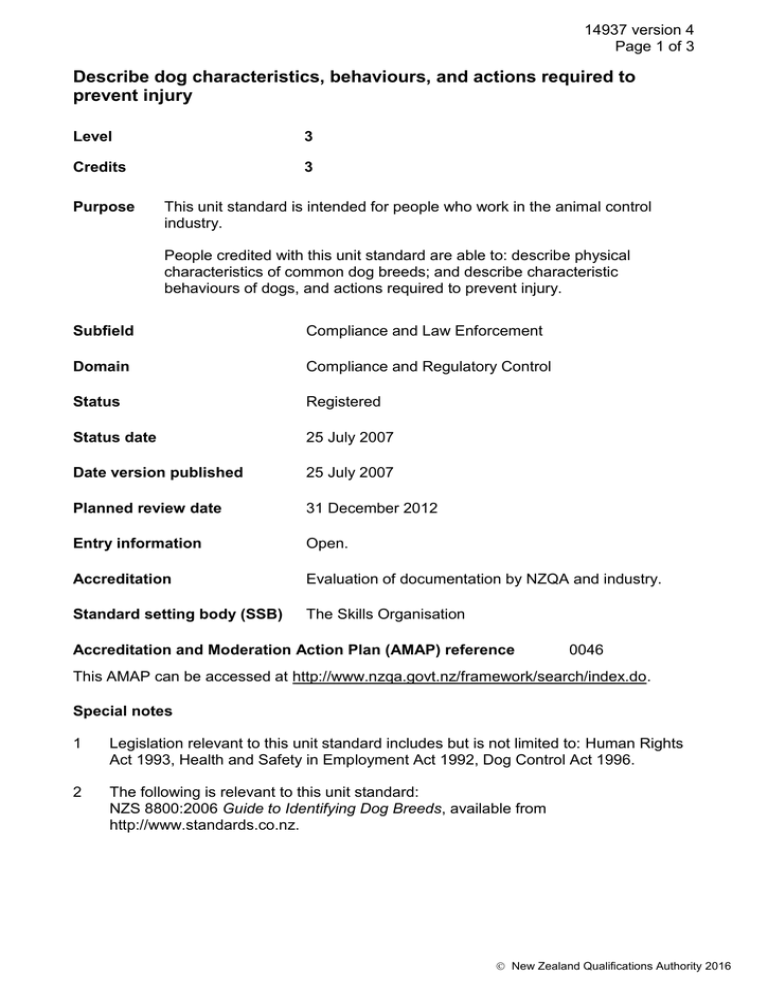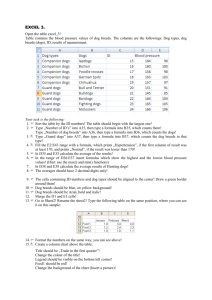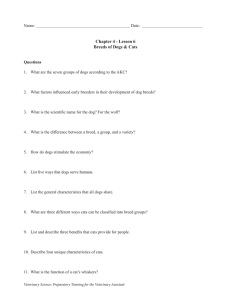Describe dog characteristics, behaviours, and actions required to prevent injury
advertisement

14937 version 4 Page 1 of 3 Describe dog characteristics, behaviours, and actions required to prevent injury Level 3 Credits 3 Purpose This unit standard is intended for people who work in the animal control industry. People credited with this unit standard are able to: describe physical characteristics of common dog breeds; and describe characteristic behaviours of dogs, and actions required to prevent injury. Subfield Compliance and Law Enforcement Domain Compliance and Regulatory Control Status Registered Status date 25 July 2007 Date version published 25 July 2007 Planned review date 31 December 2012 Entry information Open. Accreditation Evaluation of documentation by NZQA and industry. Standard setting body (SSB) The Skills Organisation Accreditation and Moderation Action Plan (AMAP) reference 0046 This AMAP can be accessed at http://www.nzqa.govt.nz/framework/search/index.do. Special notes 1 Legislation relevant to this unit standard includes but is not limited to: Human Rights Act 1993, Health and Safety in Employment Act 1992, Dog Control Act 1996. 2 The following is relevant to this unit standard: NZS 8800:2006 Guide to Identifying Dog Breeds, available from http://www.standards.co.nz. New Zealand Qualifications Authority 2016 14937 version 4 Page 2 of 3 3 Definitions Organisational requirements refers to instructions to staff on policy and procedures which are documented in memo or manual format and are available in the workplace. These include legislative requirements; Common dog breeds refers to predominant breeds found in New Zealand; Toy refers to miniature house dogs and may include but are not limited to – Poodles, Pekingese, Chihuahua; Small refers to dogs that measure between 300 and 400 millimetres in height and weigh an average of seven kilos. Small dogs may include but are not limited to – Jack Russells, Cavalier King Charles Spaniels; Medium refers to dogs that measure between 330 and 550 millimetres in height. Medium dogs may include but are not limited to – Cocker Spaniels, Beagles, Bassett Hounds, Pit Bull Terriers, English Bull Terriers; Large refers to dogs that measure between 550 and 790 millimetres in height. Large dogs may include but are not limited to – German Shepherds, Rottweilers, Labradors, Dobermann Pinschers, Great Danes, Irish Wolf Hounds, Saint Bernards. Elements and performance criteria Element 1 Describe physical characteristics of common dog breeds. Range dog breeds include but are not limited to those that fall into the following categories – toy, small, medium, large; evidence is required for at least three breeds for the toy, small, and medium categories; and for at least six breeds for the large category. Performance criteria 1.1 Description of physical characteristics of dog breed links accurately to real life dog of the same breed. Range description includes but is not limited to – colour, size, ears, tail (or not), nose, markings, coat. Element 2 Describe characteristic behaviours of dogs, and actions required to prevent injury. Performance criteria 2.1 Visible evidence of characteristic behaviours is described accurately and completely in accordance with organisational requirements. Range behaviours include but are not limited to those associated with – fear, excitement, aggression, alertness, desire to play, submission. New Zealand Qualifications Authority 2016 14937 version 4 Page 3 of 3 2.2 Actions required to prevent injury in relation to characteristic dog behaviours are described accurately and completely in accordance with organisational requirements. Range behaviours include but are not limited to those associated with – fear, excitement, aggression, alertness. Please note Providers must be accredited by NZQA, or an inter-institutional body with delegated authority for quality assurance, before they can report credits from assessment against unit standards or deliver courses of study leading to that assessment. Industry Training Organisations must be accredited by NZQA before they can register credits from assessment against unit standards. Accredited providers and Industry Training Organisations assessing against unit standards must engage with the moderation system that applies to those standards. Accreditation requirements and an outline of the moderation system that applies to this standard are outlined in the Accreditation and Moderation Action Plan (AMAP). The AMAP also includes useful information about special requirements for organisations wishing to develop education and training programmes, such as minimum qualifications for tutors and assessors, and special resource requirements. Comments on this unit standard Please contact The Skills Organisation info@skills.org.nz if you wish to suggest changes to the content of this unit standard. New Zealand Qualifications Authority 2016






